Huawei Technologies S7-303U HUAWEI MediaPad User Manual
Huawei Technologies Co.,Ltd HUAWEI MediaPad
User Manual
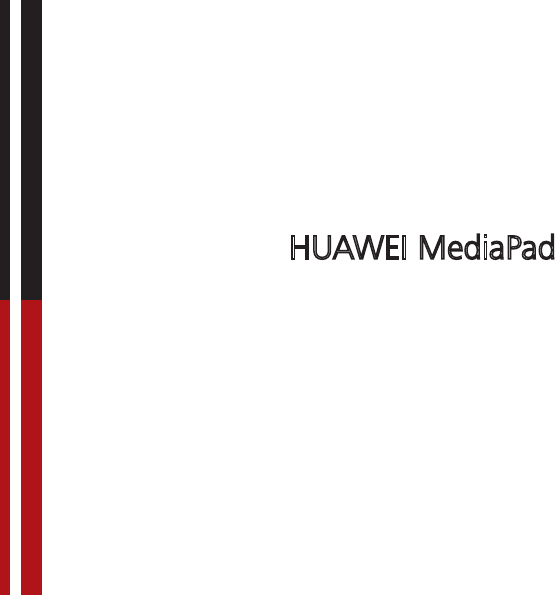
Quick Start
HUAWEI MediaPad
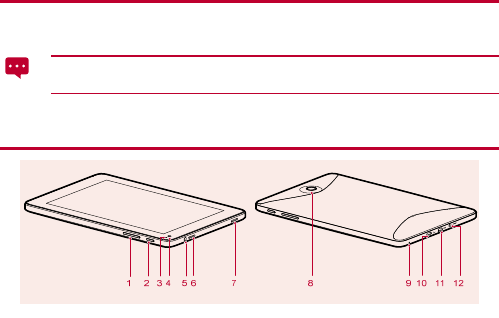
1
1 For More Help
For more help, go to http://www.huaweidevice.com to download the
User Guide
.
To find the
User Guide
of your tablet quickly, enter MediaPad in the webpage search box.
The figures in this guide are provided for your reference only. The appearance
and display features may vary slightly depending on the actual product version.
2 MediaPad at a Glance
1 Volum e key 7 Speaker
2 Power button 8 Main camera
3 Light sensor 9 Microphone
4 Front camera 10 Micro-USB port
5 Headphone jack 11 HDMI port
6 Spea ker 12 Charger port
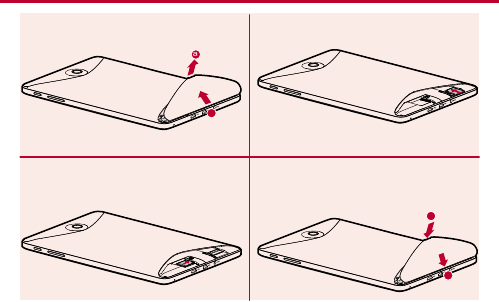
2
3 Installing the SIM and microSD Cards
b
a
b
21
34
1. Remove the back cover.
2. Install the SIM card. When installing the SIM card, insert the card gently until it
clicks firmly into place.
3. Install the microSD card.
4. Replace the back cover.
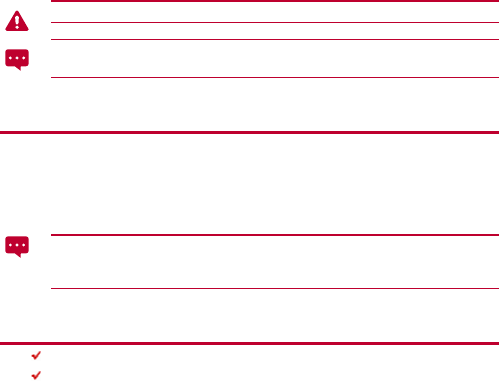
3
Do not remove the cover for the main camera.
When charging your MediaPad's battery for the first time, charge it for at least 6
hours to ensure that your MediaPad displays the battery information correctly.
4 Switching Your MediaPad On or Off
Press and hold the Power button until your MediaPad vibrates to switch on your MediaPad.
The first time you switch on the tablet, complete the setup by following the on-screen
instructions.
To switch off your MediaPad, press and hold the Power button until the screen displays a
dialog box, and then touch
OK
in the dialog box.
When the MediaPad is switched on or malfunctions, press and hold the Power
button for 10 seconds. After release, press and hold the Power button again until
your MediaPad vibrates, indicating that it is restarting.
5 Locking the Screen
When your MediaPad is turned on, press the Power button to lock the screen.
If your MediaPad is idle for a preset period of time, the screen will lock
automatically.
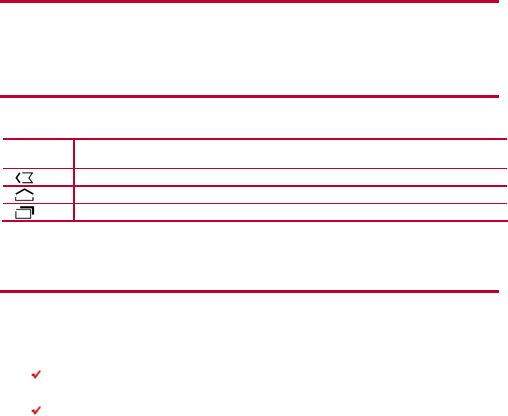
4
6 Unlocking the Screen
1. Press the Power button to wake up the screen.
2. Drag the unlock icon to any point of the circle that is around the icon.
7 Navigation Icons
The following icons are commonly used on the Home screen or other application screens.
Touch the icons to perform more operations.
Touch... To...
Return to the previous screen.
Return to the Home screen.
Open the list of recently used applications.
8 Warnings and Precautions
To use the device properly and safely, read these warnings and precautions carefully and
strictly observe them during operation. Unless otherwise specified, the term "device" refers
to the device and its accessories.
Basic Requirements
During storage, transportation, and operation of the device, keep it dry and prevent
it from colliding with other objects.
Do not dismantle the device. In case of any fault, contact an authorized service
center for assistance or repair.

5
Without authorization, no organization or individual can change the mechanical,
safety, or performance design of the device.
When using the device, observe all applicable laws and regulations and respect the
legal rights of other people.
Environmental Requirements for Using the Device
Keep the device far from sources of heat and fire, such as a heater or a candle.
Keep the device far from electronic appliances that generate strong magnetic or
electric fields, such as a microwave oven or a refrigerator.
Keep the ambient temperature between 0°C and 35°C while the device is being
charged. Keep the ambient temperature between 0°C to 35°C for using the device
powered by a battery.
Do not place any object (such as a candle or a water container) on the device. If
any foreign object or liquid enters the device, stop using the device immediately,
power it off, remove all the cables connected to it, and then contact an authorized
service center.
During thunderstorms, power off the device, and then remove all the cables
connected to it to prevent it from getting damaged due to lightning strikes.
Precautions for Using Wireless Devices
The device complies with the RF specifications when the device is used in portable
exposure conditions or at a distance of 0 cm from your body.
Do not use the device where using wireless devices is prohibited or may cause
interference or danger.
The radio waves generated by the device may interfere with the operation of
electronic medical devices. If you are using any electrical medical device, contact
its manufacturer for the restrictions on the use of the device.
Do not take the device into operating rooms, intensive care units (ICUs), or
coronary care units (CCUs).

6
Areas with Inflammables and Explosives
Do not use the device where inflammables or explosives are stored, for example, in
a gas station, oil depot, or chemical plant. Otherwise, explosions or fires may occur.
In addition, follow the instructions indicated in text or symbols.
Do not store or transport the device in the same box as inflammable liquids, gases,
or explosives.
Accessory Requirements
Use only the accessories supplied or authorized by the device manufacturer.
Otherwise, the performance of the device may get affected, the warranty for the
device or the laws and regulations related to telecommunications terminals may
become null and void, or an injury may occur.
Do not use the power adapter if its cable is damaged. Otherwise, electric shocks or
fires may occur.
Ensure that the power adapter meets the specifications indicated on the device
nameplate.
Ensure that the power adapter meets the requirements of Clause 2.5 in
IEC60950-1/EN60950-1 and it is tested and approved according to national or
local standards.
For pluggable device, the socket-outlet shall be installed near the device and shall
be easily accessible.
Battery and Charger
Unplug the charger from the electrical plug and the device when not in use.
The battery can be charged and discharged hundreds of times before it eventually
wears out. When the standby time and the talk time are shorter than the normal
time, replace the battery.
Use the AC power supply defined in the specifications of the charger. An improper
power voltage may cause a fire or a malfunction of the charger.

7
Do not connect two poles of the battery with conductors, such as metal materials,
keys, or jewelries. Otherwise, the battery may be short-circuited and may cause
injuries and burns on your body.
Do not disassemble the battery or solder the battery poles. Otherwise, it may lead
to electrolyte leakage, overheating, fire, or explosion.
If battery electrolyte leaks out, ensure that the electrolyte does not touch your skin
and eyes. When the electrolyte touches your skin or splashes into your eyes, wash
your eyes with clean water immediately and consult a doctor.
If there is a case of battery deformation, color change, or abnormal heating while
you charge or store the battery, remove the battery immediately and stop using it.
Otherwise, it may lead to battery leakage, overheating, explosion, or fire.
If the power cable is damaged (for example, the cord is exposed or broken), or the
plug loosens, stop using the cable at once. Otherwise, it may lead to an electric
shock, a short circuit of the charger, or a fire.
Do not dispose of batteries in fire as they may explode. Batteries may also explode
if damaged.
Danger of explosion if battery is incorrectly replaced. Recycle or dispose of used
batteries according to the local regulations or reference instruction supplied with
your device.
Do not disassemble or open crush, bend or deform, puncture or shred.
Do not modify or remanufacture, attempt to insert foreign objects into the battery,
immerse or expose to water or other liquids, expose to fire, explosion or other
hazard.
Only use the battery for the system for which it is specified.
Only use the battery with a charging system that has been qualified with the system
per CTIA Certification Requirements for Battery System Compliance to IEEE 1725.
Use of an unqualified battery or charger may present a risk of fire, explosion,
leakage, or other hazard.

8
Do not short circuit a battery or allow metallic conductive objects to contact battery
terminals.
Replace the battery only with another battery that has been qualified with the
system per this standard, IEEE-Std-1725-2006. Use of an unqualified battery may
present a risk of fire, explosion, leakage or other hazard.
Promptly dispose of used batteries in accordance with local regulations.
Battery usage by children should be supervised.
Avoid dropping the phone or battery. If the phone or battery is dropped, especially
on a hard surface, and the user suspects damage, take it to a service center for
inspection.
Improper battery use may result in a fire, explosion or other hazard.
For those host devices that utilize a USB port as a charging source, the host device's
user manual shall include a statement that the phone shall only be connected to CTIA
certified adapters, products that bear the USB-IF logo or products that have
completed the USB-IF compliance program.
Prevention of Hearing Damage
Using a headset at high volume can damage your hearing. To reduce the risk of damage to
hearing, lower the headset volume to a safe and comfortable level.
Safety of Children
Keep the device and its accessories out of the reach of children. Otherwise, they may
damage the device and its accessories by mistake, or they may swallow the small
components of the device, causing suffocation or other dangerous situations.
Maintenance
If the device is not used for a long time, power it off, and then remove all the cables
connected to it.

9
If any exception occurs, for example, if the device emits any smoke or unusual
sound or smell, stop using the device immediately, power it off, remove all the
cables connected to it, and then contact an authorized service center.
If the device screen is broken by colliding with hard objects, do not touch or try to
remove the broken part. In this case, stop using the device immediately, and then
contact an authorized service center in time.
Do not trample, pull, or overbend any cable. Otherwise, the cable may get
damaged, causing malfunction of the device.
Before cleaning the device, stop using it, power it off, and then remove all the
cables connected to it.
Use a clean, soft, and dry cloth to clean the device shell. Do not use any cleaning
agent or spray to clean the device shell.
Traffic Security
Observe local laws and regulations while using the device. In addition, if using the
device while driving a vehicle, comply with the following guidelines:
Concentrate on driving. Your first responsibility is to drive safely.
Do not talk on the device while driving. Use hands-free accessories.
When you have to make or answer a call, park the vehicle at the road side before
using your device.
RF signals may affect electronic systems of motor vehicles. For more information,
consult the vehicle manufacturer.
In a motor vehicle, do not place the device over the air bag or in the air bag
deployment area. Otherwise, the device may hurt you owing to the strong force
when the air bag inflates.
Do not use your device while flying in an aircraft. Power off your device before
boarding an aircraft. Using wireless devices in an aircraft may cause danger to the
10
operation of the aircraft and disrupt the wireless telephone network. It may also be
considered illegal.
Certification Information (SAR)
This device meets guidelines for exposure to radio waves.
Your device is a low-power radio transmitter and receiver. As recommended by
international guidelines, the device is designed not to exceed the limits for exposure to
radio waves. These guidelines were developed by the independent scientific organization
International Commission on Non-Ionizing Radiation Protection (ICNIRP) and include
safety measures designed to ensure safety for all users, regardless of age and health.
The Specific Absorption Rate (SAR) is the unit of measurement for the amount of radio
frequency energy absorbed by the body when using a device. The SAR value is
determined at the highest certified power level in laboratory conditions, but the actual SAR
level of the device when being operated can be well below the value. This is because the
device is designed to use the minimum power required to reach the network.
The SAR limit adopted by USA and Canada is 1.6 watts/kilogram (W/kg) averaged over
one gram of tissue. The highest SAR value reported to the FCC and IC for this device type
when tested for use in portable exposure conditions is 1.23 W/kg.
Federal Communications Commission (FCC) Statement
This device complies with part 15 of the FCC Rules. Operation is subject to the following
two conditions: (1) This device may not cause harmful interference, and (2) this device
must accept any interference received, including interference that may cause undesired
operation.
This device complies with part 68 of the FCC Rules.
Note: This equipment has been tested and found to comply with the limits for a Class B
digital device, pursuant to part 15 of the FCC Rules. These limits are designed to provide
reasonable protection against harmful interference in a residential installation. This
equipment generates, uses and can radiate radio frequency energy and, if not installed and
used in accordance with the instructions, may cause harmful interference to radio

11
communications. However, there is no guarantee that interference will not occur in a
particular installation. If this equipment does cause harmful interference to radio or
television reception, which can be determined by turning the equipment off and on, the
user is encouraged to try to correct the interference by one or more of the following
measures:
Reorient or relocate the receiving antenna.
Increase the separation between the equipment and receiver.
Connect the equipment into an outlet on a circuit different from that to which the
receiver is connected.
Consult the dealer or an experienced radio/TV technician for help.
Warning: Changes or modifications made to this device not expressly approved by Huawei
Technologies Co., Ltd. may void the FCC authorization to operate this device.
9 Personal Information and Data Security
The use of some functions or third-party applications on your device could result in your
personal information and data being lost or becoming accessible to others. Several
measures are recommended to help you protect personal and confidential information.
Place your device in a safe area to prevent it from unauthorized use.
Set your device screen to lock and create a password or unlock pattern to open it.
Periodically back up personal information kept on your SIM/UIM card, memory card,
or stored in your device memory. If you change to a different device, be sure to
move or delete any personal information on your old device.
If you are worried about viruses when you receive messages or emails from a
stranger, you can delete them without opening them.
If you use your device to browse the Internet, avoid websites that might pose a
security risk to avoid theft of your personal information.

12
If you use services such as Wi-Fi tether or Bluetooth, set passwords for these
services to prevent unauthorized access. When these services are not in use, turn
them off.
Install or upgrade device security software and regularly scan for viruses.
Be sure to obtain third-party applications from a legitimate source. Downloaded
third-party applications should be scanned for viruses.
Install security software or patches released by Huawei or third-party application
providers.
Some applications require and transmit location information. As a result, a
third-party may be able to share your location information.
Your device may provide detection and diagnostic information to third-party
application providers. Third party vendors use this information to improve their
products and services.
If you have concerns about the security of your personal information and data,
please contact mobile@huawei.com.
10 Legal Notice
Copyright © Huawei Technologies Co., Ltd. 2011. All rights reserved.
No part of this document may be reproduced or transmitted in any form or by any means
without prior written consent of Huawei Technologies Co., Ltd.
The product described in this manual may include copyrighted software of Huawei
Technologies Co., Ltd. and possible licensors. Customers shall not in any manner
reproduce, distribute, modify, decompile, disassemble, decrypt, extract, reverse engineer,
lease, assign, or sublicense the said software, unless such restrictions are prohibited by
applicable laws or such actions are approved by respective copyright holders.

13
Trademarks and Permissions
, , and are trademarks or registered trademarks of Huawei
Technologies Co., Ltd.
HDMI, the HDMI Logo, and High-Definition Multimedia Interface are trademarks or
registered trademarks of HDMI Licensing LLC in the United States and other countries.
Content owners use Microsoft PlayReady™ content access technology to protect their
intellectual property, including copyrighted content. This device uses PlayReady
technology to access PlayReady- protected content and/or WMDRM-protected content. If
the device fails to properly enforce restrictions on content usage, content owners may
require Microsoft to revoke the device’s ability to consume PlayReady-protected content.
Revocation should not affect unprotected content or content protected by other content
access technologies. Content owners may require you to upgrade PlayReady to access
their content. If you decline an upgrade, you will not be able to access content that requires
the upgrade.
Other trademarks, product, service and company names mentioned are the property of
their respective owners.
Notice
Some features of the product and its accessories described herein rely on the software
installed, capacities and settings of local network, and therefore may not be activated or
may be limited by local network operators or network service providers. Thus the
descriptions herein may not match exactly the product or its accessories you purchase.
Huawei Technologies Co., Ltd. reserves the right to change or modify any information or
specifications contained in this manual without prior notice and without any liability.
Third-Party Software Statement
Huawei Technologies Co., Ltd. does not own the intellectual property of the third-party
software and applications that are delivered with this product. Therefore, Huawei
14
Technologies Co., Ltd. will not provide any warranty of any kind for these third-party
software and applications. Neither will Huawei Technologies Co., Ltd. provide support to
customers who use these third-party software and applications, nor be responsible or liable
for the functions of these third-party software and applications.
Third-party software and applications services may be interrupted or terminated at any time.
Huawei Technologies Co., Ltd. does not guarantee that any content or service would be
maintained for any period during its availability. Third-party service providers provide
content and services through network or transmission tools outside of the control of Huawei
Technologies Co., Ltd. To the greatest extent permitted by applicable law, it is explicitly
stated that Huawei Technologies Co., Ltd. shall not compensate or be liable for services
provided by third-party service providers, or the interruption or termination of third-party
contents or services.
Huawei Technologies Co., Ltd. shall not be responsible for the legality , quality, or any other
aspects of any software installed on this product, or for any uploaded or downloaded
third-party works, such as texts, images, videos, or software. Customers shall bear the risk
for any and all effects, including incompatibility between the software and this product,
which result from installing software or uploading or downloading the third-party works.
This product uses the open-sourced Android operating system. Huawei Technologies Co.,
Ltd. has made necessary changes to the system. Therefore, this product may not support
all the functions that are supported by the standard Android operating system or may be
incompatible with third-party software. Huawei Technologies Co., Ltd. shall not be liable for
any of such situation.
DISCLAIMER OF WARRANTIES
THE CONTENTS OF THIS MANUAL ARE PROVIDED “AS IS”. EXCEPT AS REQUIRED
BY APPLICABLE LAWS, NO WARRANTIES OF ANY KIND, EITHER EXPRESS OR
IMPLIED, INCLUDING BUT NOT LIMITED TO, THE IMPLIED WARRANTIES OF
MERCHANTABILITY AND FITNESS FOR A PARTICULAR PURPOSE, ARE MADE IN
RELATION TO THE ACCURACY, RELIABILITY OR CONTENTS OF THIS MANUAL.
15
LIMITATIONS OF LIABILITY
TO THE MAXIMUM EXTENT PERMITTED BY APPLICABLE LAW, IN NO EVENT SHALL
HUAWEI TECHNOLOGIES CO., LTD. BE LIABLE FOR ANY SPECIAL, INCIDENTAL,
INDIRECT, OR CONSEQUENTIAL DAMAGES, OR LOST PROFITS, BUSINESS,
REVENUE, DATA, GOODWILL OR ANTICIPATED SAVINGS.
THE MAXIMUM LIABILITY (THIS LIMITATION SHALL NOT APPLY TO LIABILITY FOR
PERSONAL INJURY TO THE EXTENT APPLICABLE LAW PROHIBITS SUCH A
LIMITATION) OF HUAWEI TECHNOLOGIES CO., LTD. ARISING FROM THE USE OF
THE PRODUCT DESCRIBED IN THIS DOCUMENT SHALL BE LIMITED TO THE
AMOUNT PAID BY CUSTOMERS FOR THE PURCHASE OF THIS PRODUCT.
Import and Export Regulations
Customers shall comply with all applicable export or import laws and regulations and be
responsible to obtain all necessary governmental permits and licenses in order to export,
re-export or import the product mentioned in this manual including the software and
technical data therein.
Issue: 01 (2011–08–13)
Part Number: 31010GHX

for Android™ Android is a trademark of Google Inc. Use of this trademark is subject to
Google Permissions.